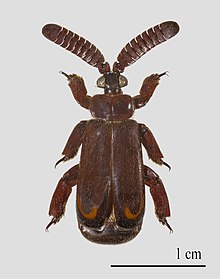Paussini
| Ant nest beetles | |
|---|---|
 |
|
|
Cerapterus pilipennis (Paussini : Cerapterina) |
|
| Scientific classification | |
| Kingdom: | Animalia |
| Phylum: | Arthropoda |
| Class: | Insecta |
| Order: | Coleoptera |
| Suborder: | Adephaga |
| Superfamily: | Caraboidea |
| Family: | Carabidae |
| Subfamily: |
Paussinae Latreille, 1807 |
| Tribes | |
|
Metriini LeConte, 1853 |
|
Metriini LeConte, 1853
Ozaenini Hope 1838
Paussini Latreille, 1807
Protopaussini Gestro, 1892
Ant nest beetles (subfamily Paussinae) or paussines, some members of which are known also as flanged bombardier beetles, are a large subfamily within the ground beetles (Carabidae). The tribes Metriini, Ozaenini, Paussini and Protopaussini are included in the subfamily.
Rarely seen, most Paussinae are obligate or facultative myrmecophiles, living within the nests of ants, predatory on ant larvae and workers. Many have elaborate antennal structures and body parts flattened. Paussines are moderate sized (6–20 mm), characterised by glandular hairs that produce secretions attractive to ants and by the odd antennal structures of many species. Their pygidial glands can produce explosive secretions, giving them the other name of flanged bombardier beetles although they are not particularly close relatives of the typical bombardier beetles (Brachininae).
Very little is known about the immature stages of ant nest beetles. Most appear to live in ant nests in their early stages of life. Although many are facultative or obligate myrmecophiles, most do not appear like ants (i.e. myrmecomorphic) and unlike in the case of myrmecophilous larval Lycaenidae, there appears to be no benefit gained by the ants in this association. Many species follow the trails of worker ants of specific species. Glandular secretions on their antennae and body allow them to interact with ant workers. It is believed that the beetles use an acoustic mechanism to successfully imitate the sounds of an ant queen thus permitting them access to the nest without alarming the ants. The defensive bombardier behaviour is never used against ants. Males of some species are attracted to lights during some parts of the season and are thought to disperse from one ant nest to another. Males are thought to be short-lived. These beetles feed on ant eggs, larvae and adults by piercing their mandibles into the abdomen or other soft part and sucking the contents. Apart from chemical mimicry and communication with their hosts, they also make use of vibrations. Several stridulatory structures are found in these beetles including alary-elytral, abdomen-femur and thorax-femur combinations of surfaces.
...
Wikipedia
